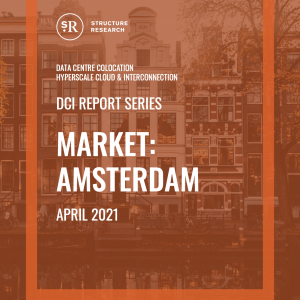Description
Amsterdam in the Netherlands is one of the top four data centre markets in Europe — colloquially known as FLAP (Frankfurt, London, Amsterdam and Paris) — and has experienced a steady growth trajectory for most of its history. Times have changed and Amsterdam is now the smallest of the FLAP markets, dropping behind Paris in terms of built-out critical MW capacity online in 2023.
Amsterdam rose to prominence as a top data centre destination and connectivity hub in Europe due to the central geographic location, terrestrial and subsea cable connectivity into most major cities in western Europe, and the Amsterdam Internet Exchange (AMS-IX), still one of the biggest IXs in the world. Amsterdam has long-time roots as a connectivity hub and the market is still dominated by retail colocation, with roughly a 60/40 split in favour of retail. This will get closer to a 50/50 split by 2026 as hyperscale deployments pick up and enterprise requirements grow in size.
Amsterdam has experienced a challenging few years, with regulatory constraints compounded by power transmission issues. Government moratoriums on new data centre builds, a complex permitting process and lack of hyperscale demand have contributed to a slower growth environment compared to many other markets in Europe. The level of hyperscale demand is lower than in other European markets given the amount of self-builds undertaken by Microsoft and Google (both outside Amsterdam) and the fact AWS is unlikely to open a full cloud infrastructure region. It was an early hyperscale cloud market when Microsoft came online in 2010 but failed to capitalise on the early promise. Only Google Cloud, Oracle Cloud and French webscaler Scaleway have Amsterdam regions alongside Azure.
Amsterdam is the smallest of the four FLAP (Frankfurt, London, Amsterdam, Paris) markets in Europe. Its central location and subsea cable connectivity made it an early interconnection hub, but growth has been on the wane since 2019 when a moratorium on new data centres was imposed without warning. This has been compounded by significant power constraints as well as further regulatory machinations. Timelines for new capacity to come online have been pushed out, in some cases repeatedly and in others indefinitely.
The dire power situation became clear in 2024 when grid operators announced that congestion will be an issue until 2030 at the earliest and that certain areas of Amsterdam could see outages from 2026. The worst congestion around Amsterdam is near Schiphol-Rijk, the main hyperscale AZ, and further north of the city where Microsoft and Google have self-builds. More concerned with keeping the lights on for households and essential services than approving more power for data centres, the utilities essentially put power requests – even those that had already been approved – on hold.
At the same time, the central government and the province of North Holland have been somewhat more positive towards the sector in recognising the value of data centres to AI and economic development, but it may be too little, too late. A more data centre-friendly government cannot overcome the issues around land and power availability, nor reluctance at the municipal level where planning decisions are made.
Furthermore, the current rules and zoning plans for the Amsterdam market only run to 2030 and there is no indication of what the regulatory environment will be after that date. Without knowing what the future data centre strategy or power situation will be, operators are reluctant to commit to significant long-term investment in Amsterdam – or indeed elsewhere in the Netherlands where land and power are also constrained. Amsterdam will remain an outlier in Europe as an enterprise-driven colocation market with limited options for hyperscale or AI development.
Despite the challenges, there is healthy demand and some early AI deployments. The Amsterdam colocation market is expected to be worth €1.6b by the end of 2025 and grow at a 5-year CAGR of 11.6%. The market is expected to exceed 900MW in 2030. In terms of built out capacity, Amsterdam was overtaken by Paris in 2024 and we forecast it will be eclipsed by both Madrid and Milan in 2030, if not sooner.
This report is an excellent resource for any service provider, investor or enterprise end user looking to understand and project the data centre market in Amsterdam or find a service provider. Structure Research now has Data Center and Interconnection reports for the European FLAP markets plus Milan and Madrid in southern Europe, as well as a new DCI Market Spotlight report on Rome.
Read the PDF executive summary HERE






